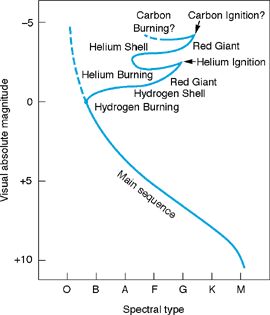|
In stars several times the mass of the Sun, they go
well beyond fusing Helium to Carbon.
For stars up to 8 times that of the Sun, they will pass through a Planetary Nebula stage, just like our Sun. Stars that begin their lives as A stars (mass range from 1.5 to just about 3 times our Sun mass) will have enough mass in their central cores to collapse and fuse Carbon into Neon or possibly Magnesium
2 B stars with masses greater than 8 Suns will fuse Neon or possibly Oxygen, into Magnesium, Sulfur and Silicon. All of this occurs at various stages in the ever shrinking, hot core. |

|
O stars have the highest initial masses of all and will fuse elements all the way to Iron at their cores! They become HUGE SUPERGIANTS.
High mass B and all O stars can not become white dwarfs. Their central cores are too massive. As we will soon see, an entirely different fate awaits them.
What About LOW MASS stars?
Stars less than about 0.4 Suns, take so long to evolve, even since
the beginning of the universe (about 15 billion years ago), these stars
are still on the main sequence and even close to their ZAMS.
Very low mass stars live from a hundred-billion to a
thousand-billion years.
Why do low mass stars live so long?
- 1) They have such low mass, they needn't burn much energy to hold themselves up against their own gravity.
- 2) Very small stars are convective through out their entire radius. This means its constantly recycling new material into its core for burning, extending its lifetime even more.